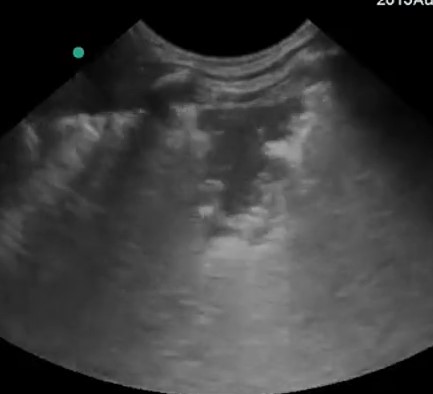Introduction – What is the Wedge Sign?
We have known that Vet BLUE® could help screen for pulmonary thromboembolism (PTE)/pulmonary embolism (PE) for over a decade by finding the “Wedge Sign” (our term). Just like a renal infarction, lung infarction is the same - a triangular or wedge shape of necrosis in its most extreme periphery. The Wedge Sign is more of a Tissue Sign than a Shred Sign and is indistinguishable from pneumonia/other pathology of consolidation when in gravity-dependent Vet BLUE® regions. However, when the Wedge Sign is in upper non-gravity dependent Vet BLUE® regions of caudodorsal and perihilar where pneumonia is not expected, PTE/PE should be suspected and listed as a differential.

Figure 2: Wedge sign diagram with example. Used with permission courtesy of Dr. Greg Lisciandro, DVM, DABVP, DACVECC of FASTVet.com and Point-of-care Ultrasound Techniques for the Small Animal Practitioner, ©2021.
Differentiating PTE from PE
PTE is when the thrombus if formed away from the lung, breaks off, and travels to lung causing infarction. PE is when the organ of the thrombus is directly at the site of lung infarction.

Figure 1: PTE with characteristic wedge sign.
Use of TFAST® and Global FAST®
Integrating other information during Global FAST® is important to look for any sonographic risk factors and co-morbidities. TFAST® is used for several reasons including acute right ventricular dilation, distended pulmonary arteries, thrombi including saddle thrombus at the bifurcation of the pulmonary arteries at or just above the Mercedes Benz view on short-axis and on the long axis, and detection of heartworms (Dirofilaria immitis).
During AFAST®, ascites and soft tissue abnormalities such as intra-abdominal masses including lymph nodes, torsions, renal infraction, etc. may be detected and placed into clinical context.
Learn More
You can learn more about the relationship between the wedge sign and PTE in this recent article from the Journal of Veterinary Emergency and Critical Care, titled “The wedge sign: A possible lung ultrasound sign for pulmonary thromboembolism” (available in early view at the time of this blog).